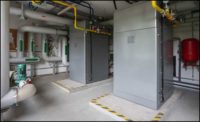One definition for institutional building includes buildings that “typically contain large numbers of people interacting to accomplish a general or specific purpose.” ASHRAE doesn’t have an institutional building category in its 2015 HVAC Application Handbook, but instead breaks out these “buildings typically containing large numbers of people” into more specific categories, e.g., retail facilities, commercial and public buildings, etc.
As I think about institutional buildings, I came up with a list of common problems that can have serious detrimental results to its occupants. It got me thinking that it would be helpful to design engineers and building operating engineers to have a master checklist of issues and concerns that can be referred to when drafting a building program, proceeding with the project design, and sustaining these preventive measures through facility management. Here is my first pass at such a checklist for institutional buildings, and I welcome you to offer your suggestions to this list.
1. Safety
a. Personal safety
i. Inside the building
ii. Outside the building
b. Health safety
i. Indoor air quality
ii. Infection control
iii. During renovation and/or adjacent new construction
c. Equipment and system safety
i. Training of personnel
ii. Necessary personal protection equipment
d. Environmental safety
i. Inside the building spills
ii. Smoke and toxic gases from within and/or from outdoor air intakes
e. Building safety
i. Security consultant requirements
ii. Floods and other natural disasters
f. Emergency planning
i. Evacuating the building
ii. Safe room(s) within the building
iii. Natural disasters
2. Energy & water conservation and associated operating cost
a. Electrical
i. Peak demand
1. Demand-side management
2. Load-shedding
ii. Off-peak consumption
1. Thermal storage
b. Water
i. Water recovery
1. Water-to-water
2. Air-to-water
ii. Ground water and other external water resources
c. Energy management and energy recovery
i. Cogeneration
ii. Building automation
iii. Continuous commissioning
iv. Remote building/energy management
d. Recommissioning
i. HVAC plumbing, electrical systems
ii. Air and water system balancing tune-up
iii. Primary equipment tune-ups
iv. Electrical power panel tune-up
v. Domestic water and other portable and non-portable water system tune-ups
e. Recommended annual operating budget
i. Utility costs
ii. Facility and operation staff costs
3. Maintenance
a. Access to equipment
i. Within building
ii. Via ladder versus stair and/or elevator
iii. On pitched roof and/or in vicinity of building roof edge
b. Building exterior
c. Building interior
d. Equipment end-of-useful life
e. Maintenance work order system
f. Certifications and licenses
4. Equipment
a. Proprietary
b. Standardization
c. Inadequate operation and maintenance manuals
d. Inadequate/vague service contracts
5. Personnel Training
a. During the design phase
b. At the end of construction document phase
c. At field coordination drawing phase
d. At startup
e. At commissioning functional performance test demonstration
6. Building structure
a. Moisture infiltration
i. Exterior facade
ii. Roof(s)
iii. Foundation
b. End of useful service life
i. Replace
ii. Rebuild in place
c. Fire stop
i. Above ceilings
ii. To floor above
iii. Rated walls
iv. Smoke barriers
d. Ventilation & exhaust
i. Air filtration
ii. Location of intake to exhaust
iii. Adjacent building intakes and exhaust
ES





